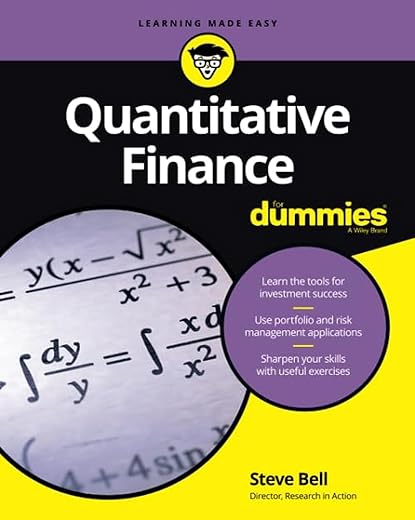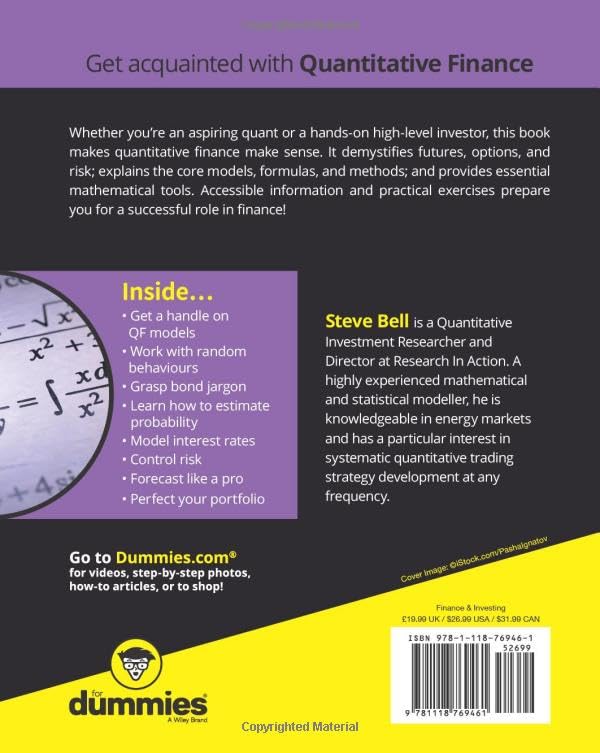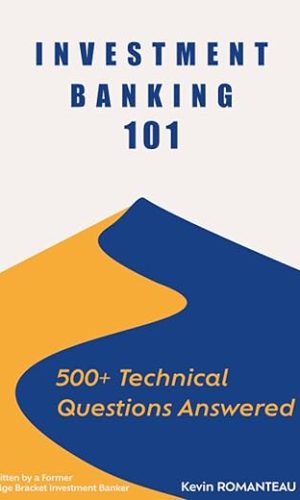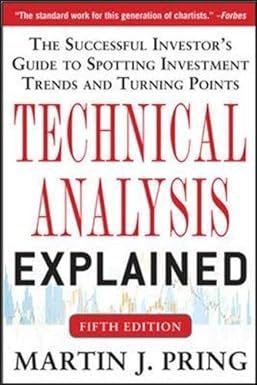Quantitative Finance For Dummies
£18.20£21.80 (-17%)
Does the complex world of quantitative finance make you quiver? You’re not alone! It’s a tough subject for even high-level financial gurus to grasp, but Quantitative Finance For Dummies offers plain-English guidance on making sense of applying mathematics to investing decisions. With this complete guide, you’ll gain a solid understanding of futures, options and risk, and get up-to-speed on the most popular equations, methods, formulas and models (such as the Black-Scholes model) that are applied in quantitative finance.
Also known as mathematical finance, quantitative finance is the field of mathematics applied to financial markets. It’s a highly technical discipline—but almost all investment companies and hedge funds use quantitative methods. This fun and friendly guide breaks the subject of quantitative finance down to easily digestible parts, making it approachable for personal investors and finance students alike. With the help of Quantitative Finance For Dummies, you’ll learn the mathematical skills necessary for success with quantitative finance, the most up-to-date portfolio and risk management applications and everything you need to know about basic derivatives pricing.
• Covers the core models, formulas and methods used in quantitative finance
• Includes examples and brief exercises to help augment your understanding of QF
• Provides an easy-to-follow introduction to the complex world of quantitative finance
• Explains how QF methods are used to define the current market value of a derivative security
Whether you’re an aspiring quant or a top-tier personal investor, Quantitative Finance For Dummies is your go-to guide for coming to grips with QF/risk management.
Read more
Additional information
| Publisher | 1st edition (7 Aug. 2016), For Dummies |
|---|---|
| Language | English |
| Paperback | 408 pages |
| ISBN-10 | 1118769465 |
| ISBN-13 | 978-1118769461 |
| Dimensions | 18.54 x 2.54 x 23.37 cm |












by Dr. A. Davies
As the previous reviewer has commented I would agree that what Steve Bell has achieved in this book is to be applauded. To attempt to write a book that is accessible on a subject as complex as quantitative finance is no mean feat. The author has written a book that is easy to read yet gives a thorough treatment of this interesting but intricate area of finance.
Some maths is necessary but the author introduces this gradually in order to explain the key finance concepts.
I would suggest this book could be read as a primer to both practitioners and advanced undergraduate or early postgraduate students looking for an accessible introduction to the subject. In addition chapters on risk/portfolio management and market trading/strategy would be of interest to private investors looking to improve their understanding of modern portfolio theory.
I would highly recommend this book.
by Simon
Nice, covers that basics well.
by Maxim Egorushkin
Incredibly well written book. Cannot recommend it enough for beginners and practitioners.
by Robert Carver
The “For Dummies” series exists to explain complicated subjects in a simple way. This is hard (I speak from experience). Also the more complex the subject, the harder it will be to write this kind of book. It probably doesn’t get much harder than Quantitative Finance (unless you’re currently trying to read Quantum Physics for Dummies). Author Steve Bell, who has brought us “Quantitative Finance for Dummies” (Wiley, 2016), clearly relishes a challenge. He has risen to it admirably.
Let’s start with what this book is not. It’s not an attempt to replace text books such as those by the likes of John Hull and Paul Wilmott which cover this subject in more advanced detail. Nor is it for the lay reader who is curious about this weird discipline but has no interest in getting any deeper understanding (something like Scott Patterson’s book “The Quants”, Gillian Tett’s Fools Gold, or “The Predictors” by Tom Bass would suit them better). Instead it’s aimed at two groups – aspiring or potential quants, and those working close to quants who want to better understand what they do.
As well as covering the usual pricing models there also sections on risk and portfolio management, and on market trading and strategy. It’s great to see these here – there is much more to being a Quant than pricing exotic derivatives (especially post 2008).
Some maths is inevitable in this subject, but this is kept to a minimum, and interspersed with plenty of more intuitive explanations. Real world examples are plentiful, and make the maths more palatable.
If you’ve read a “for dummies” before you’ll know what to expect in terms of structure and layout. This isn’t to everyone’s taste but there is no denying that they get the information across effectively.
More than anything, this book helps you to think like a Quant; or at least understand how Quants think.
“Quantitative Finance for Dummies” is a highly readable and accessible book which does a great job of introducing a wide range of topics to non specialists working in the industry, and readers considering a career or academic course in the discipline.
Robert Carver, ex-quantitative hedge fund manager, independent trader, and author of “Systematic Trading” (Harriman House, 2015)
by Amazon Customer
If this is for dummies then either I’m an idiot or the title is not true.
Part I, Chapter 3: Random behaviours, page 48 – this is where I got lost. Lack of explanation, on p. 49 author starts grabbing unseen formulas out of nowhere without any justification trying to prove something.
“The expected value, V(X) = E((X-E(X))^2), of a random variable, X, is given by the formula: E(X)”
This is the first time I’m seeing this formula. If you are talking about expected value, why are you giving me a formula for variance? And how can you subtract anything from X, a variable – not a value?
I am very disappointed. Can anyone point me to a quantitative finance literature for ACTUAL dummies?
by dennis
Don’t bother reading this book until you have re studied A level pure maths , especially calculus
by MR. P.
Cheap good, and on time